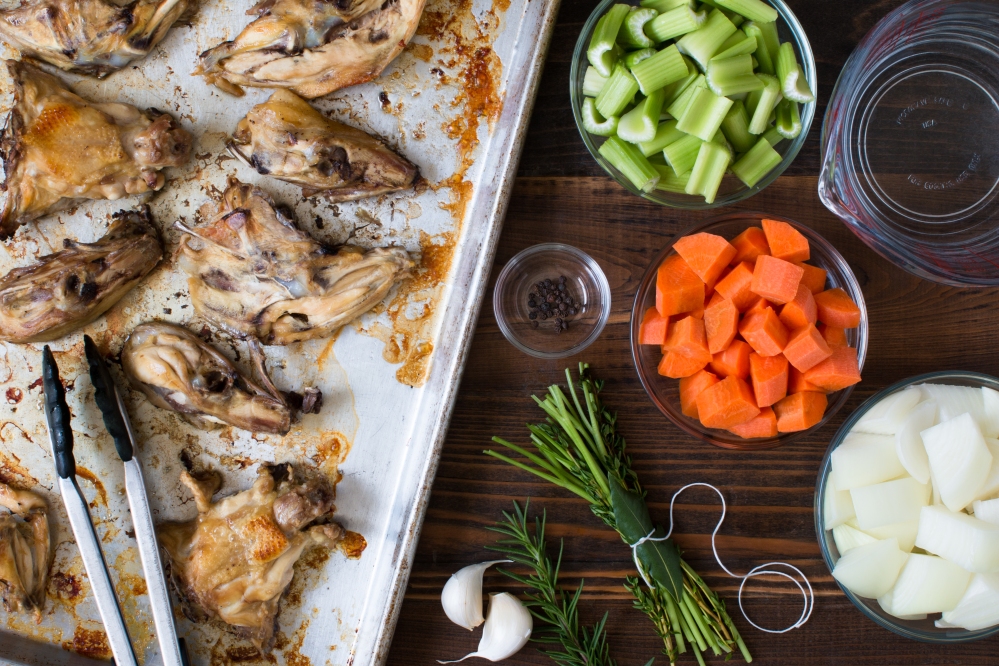Basic Chicken Stock
August 23, 2019 • 0 comments

Directions

I always try to have a quart or two of chicken stock on hand at all times. Store bought is convenient but homemade is a real treat, especially if the bones are from pasture-raised chickens; the flavor!
I used broth bones from Grove Ladder Farm, a small, family-run farm in Sarasota, Florida. Their Cornish Cross chickens are raised in pens that are moved around their farm regularly to give their chickens fresh grass, insects, worms…all the stuff that chickens love… and make them taste good.
Note: You can also make this stock using chicken necks or chicken feet. Using chicken feet, which are mostly skin and tendons, will result in a more gelatinous stock… like Grandma used to make.
Note: While this post is specifically about making chicken stock, the same recipe and technique may be used to make stock using turkey, ducks, or other poultry.
If you happen to live in the Sarasota, Florida area stop by their booth at the Downtown Sarasota Farmer’s Market every Saturday from 7:30 AM to 1:00 PM, but get there early as they usually sell out, especially eggs, or you can order their products (local delivery only) through their online store.


The color of this stock is a rich yellow and that is because I roasted the bones. Roasting also adds another layer of flavor to the finished stock. If I use bones from commercially available chickens I will usually blanch the bones before roasting. Blanching the bones will get rid of impurities that would make the stock cloudy. However, with birds this pristine from Grove Ladder Farm I skip this step.
INGREDIENTS

1 pack of Grove Ladder Farm broth bones or 1 1/2 lbs of chicken bones
3 cups medium diced yellow or Spanish onions (1 large onion)
1 1/2 cups medium dice carrots (4 – 6 stalks)
1 1/2 cups medium dice celery (1 large carrot)
3 qts of water
Herb bundle (bouquet garni)10-12 fresh parsley stems
3 fresh thyme sprigs
1 bay leaf
1 fresh rosemary sprig (optional)
12-inch long kitchen twine
10-12 black peppercorns
2 garlic cloves (optional)
DIRECTIONS
Preparation:


Preheat the oven to broil; place a rack at the topmost level.
If you have a whole carcass, which includes the breast and back bones, cut it into smaller pieces, place into a roasting pan or onto a baking tray as long as it has at least one-inch tall side walls.
Place the roasting pan or tray into the preheated oven and onto the topmost level.Note: If you use a roasting pan you may need to place the rack in the oven at the second from the top level; roasting pans tend to be taller than baking tray.s
Broil on one side for 10-15 minutes, turn over, roast for another 10 minutes or until the bones are nicely browned. Make sure not to burn the bones as they will make the stock bitter.
Carefully remove the pan/tray from the oven, place the roasted bones into a large stockpot.
Deglaze the pan/tray: Add about 1 to 2 cups of water to the pan/tray and using a wooden spoon scrape the little bits of roasted bits of meat from the bottom, pour the mixture into the stock pot with the roasted bones.
FOOD SAFETY TIP!Make sure to wash everything used in preparing raw chicken such as kitchen tools, cutting boards, containers, surfaces, and especially your hands in hot soapy water afterward to prevent cross-contamination.
Also, I use the added precaution against cross-contamination of using a yellow cutting board just for poultry.
Cooking:
Add the onions, carrots, celery, bouquet garni, and black peppercorns to the stockpot, place on a burner set to medium-high, bring to a boil then reduce to a brisk simmer, cook for 3 hours.
After cooking remove the bouquet garni, strain the stock into a thin walled pot or bain-marie, cool in an ice bath.
Ladle the stock into plastic storage containers with watertight lids, use immediately or store in the fridge for up to seven days or in the freezer for up to six months.
Note: Pasture-raised chickens are leaner than commercial chickens, therefore you most likely will not have a lot of extra fat to remove. If you do, the easiest way to remove any excess fat is to chill the stock in the fridge then remove the fat that has solidified at the top of the container.

ENJOY!
Basic Chicken Stock



